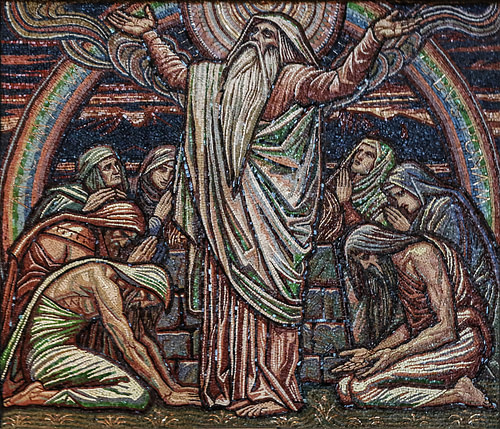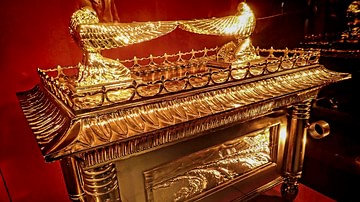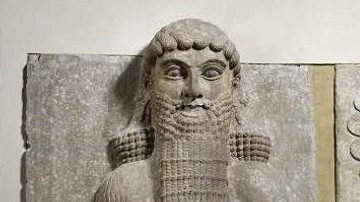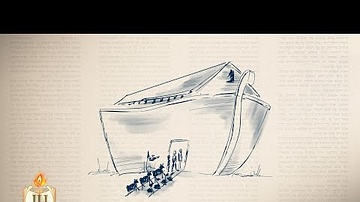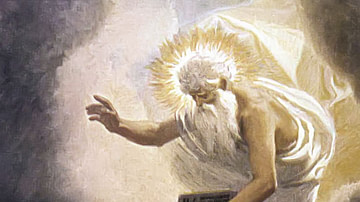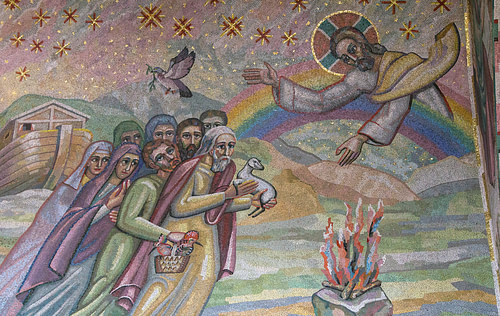
Noah is considered one of the patriarchs in the Jewish Scriptures or one of the founding fathers of what became the religion of Judaism. His story begins in Genesis 6 and consists of three elements: the evil of the earth; the flood narrative; Noah’s descendants in the list of the nations of the world. Noah was the son of Lamech and lived to be 500 years old.
The Evil of the World
When human beings began to increase in number on the earth and daughters were born to them, the sons of God saw that the daughters of humans were beautiful, and they married any of them they chose. Then the Lord said, "My Spirit will not contend with humans forever, for they are mortal; their days will be a hundred and twenty years." The Nephilim were on the earth in those days—and also afterward—when the sons of God went to the daughters of humans and had children by them. They were the heroes of old, men of renown. (Genesis 6:1-4)
"Nephilim" in Hebrew is difficult to translate. From the root of this word, it has often been translated as "those who do violence", and it came into the King James version as "giants". Many ancient cultures had folklore tales of giants in the distant past. Later Jewish traditions claimed that the sons of God were angels and when these fallen angels mated with women, they also taught humans the art of metallurgy. This led to two evils, the coining of money and weapons of war. In the apocalyptic literature of the visions of Enoch, they are called the Watchers. This text claimed that they were punished by God by being chained in the lowest pits of She’ol, an early Jewish concept of Hell.
The Lord saw how great the wickedness of the human race had become on the earth, and that every inclination of the thoughts of the human heart was only evil all the time. The Lord regretted that he had made human beings on the earth, and his heart was deeply troubled. So, the Lord said, "I will wipe from the face of the earth the human race I have created—and with them the animals, the birds and the creatures that move along the ground—for I regret that I have made them." But Noah found favor in the eyes of the Lord. (Genesis 6:5-8)
We read that Noah was "a righteous man, blameless among the people of his time, and he walked faithfully with God. Noah had three sons: Shem, Ham and Japheth" (Genesis 6:9-10). God told Noah that he was going to "put an end to all people" (Genesis 6:13). For centuries, this passage has been analyzed in relation to understanding the nature of God. If God is omniscient (all-knowing), did he not know that humans would commit evil? How could God change his mind about his creation? However, this story was not unique. Other cultures had stories of a god or the gods punishing humans for their evil. In Egyptian mythology, the sun god Ra, sent his daughter Sekhmet (the lion goddess) to slaughter humans. He then had to undo her destruction when it appeared that all humans would be destroyed and so he made her drunk by beer that resembled blood to stop the slaughter. In Greek mythology, the god Zeus also wanted to punish humans (see below).
The Ark
So, make yourself an ark of cypress wood; make rooms in it and coat it with pitch inside and out. This is how you are to build it: The ark is to be three hundred cubits long, fifty cubits wide and thirty cubits high. Make a roof for it, leaving below the roof an opening one-cubit high all around. Put a door in the side of the ark and make lower, middle and upper decks. I am going to bring floodwaters on the earth to destroy all life under the heavens, every creature that has the breath of life in it. Everything on earth will perish. But I will establish my covenant with you, and you will enter the ark—you and your sons and your wife and your sons’ wives with you. You are to bring into the ark two of all living creatures, male and female, to keep them alive with you. Two of every kind of bird, of every kind of animal and of every kind of creature that moves along the ground will come to you to be kept alive. You are to take every kind of food that is to be eaten and store it away as food for you and for them. (Genesis 6:14-21)
If the cubit was the royal cubit (from the tip of the longest finger to the elbow), then the dimensions would equal 450 feet long, 75 feet wide, and 45 feet high, or about 135 meters long, 23 meters wide, and 14 meters high. Imagine the length of a football field; this was a very big boat. The reference to "two of all living creatures" is so that the animals could repopulate the earth after the flood. This is why Noah and his family bring their wives with them. Like other places in the Scriptures, we have two stories. This is the result of later editing from different sources. The second story has Noah taking seven of the clean and unclean animals, which most likely came from a priestly source as priests were concerned with purity issues.
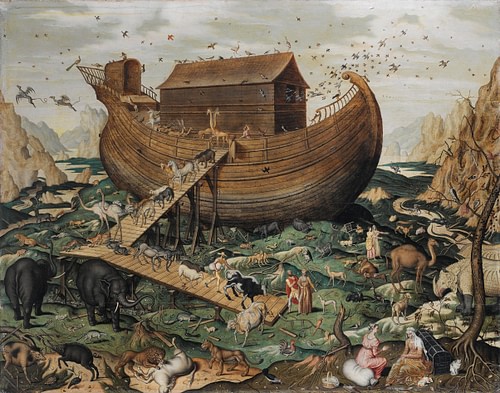
The Flood
The skies opened, and it rained for 40 days and 40 nights. In context, the 'forty' often refers to a generation. In this story, however, it simply means a very long time. Flood stories are found in ancient cultures the world over. When archaeologists began excavations in the Middle East in the Victorian Era, they uncovered cuneiform tablets and deciphered them. They were surprised to find the Epic of Gilgamesh, an ancient Mesopotamian flood story located in the Fertile Crescent, between the Tigris and Euphrates rivers. (These rivers flooded each year, and like the Nile, deposited fertile silt for agriculture.) The details are so close that many scholars believe that this was the inspiration for the flood story in Genesis.
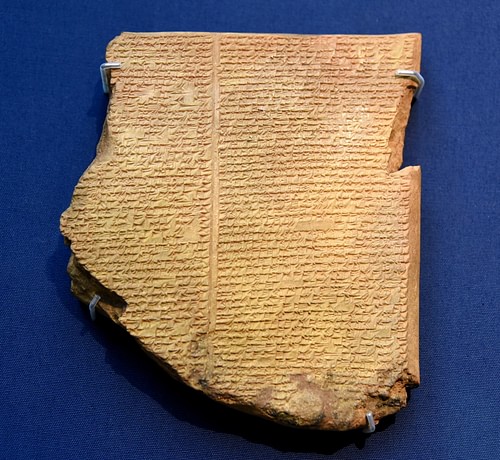
The Greeks had the myth of Deucalion, the son of Prometheus. When Zeus decided to punish humans for their hubris and disrespect, Prometheus advised his son to build a boat and fill it with animals. Again, with similar details in the Noah story, later Jewish writers claimed that this proved the existence of Noah. Zoroastrianism in ancient Persia claimed that their high god, Ahura Mazda warned of a severe storm that contained melted snow. In this case, an enclosure was to be built with only the fittest men and women and two of every animal to repopulate the earth.
When the rains ceased, Noah sent out birds to find dry land. A dove returned with an olive branch in its mouth (which has become an iconic symbol of peace).
Then Noah built an altar to the Lord and, taking some of all the clean animals and clean birds, he sacrificed burnt offerings on it. The Lord smelled the pleasing aroma and said in his heart: "Never again will I curse the ground because of humans, even though every inclination of the human heart is evil from childhood. And never again will I destroy all living creatures, as I have done. As long as the earth endures, seedtime and harvest, cold and heat, summer and winter, day and night, will never cease." (8:20-22)
The Covenant Between God & Noah
Covenants in the ancient world were essentially contracts between gods and humans. Covenants contained the criteria for humans to behave to obtain the protection of the gods. Abraham had the first covenant with the God of Israel, and Noah will have his own, with some added stipulations:
Then God blessed Noah and his sons, saying to them, "Be fruitful and increase in number and fill the earth. The fear and dread of you will fall on all the beasts of the earth, and on all the birds in the sky, on every creature that moves along the ground, and on all the fish in the sea; they are given into your hands. Everything that lives and moves about will be food for you. Just as I gave you the green plants, I now give you everything. But you must not eat meat that has its lifeblood still in it. And for your lifeblood I will surely demand an accounting. I will demand an accounting from every animal. And from each human being, too, I will demand an accounting for the life of another human being. Whoever sheds human blood, by humans shall their blood be shed; for in the image of God has God made mankind . . . never again will there be a flood to destroy the earth." (9:1-11)
This is when it is important to understand not only the many different sources of the Jewish Scriptures but the editing process as well. The books as we know them today were edited several times over the centuries. The later book of Leviticus explained how to do sacrifices, the ritual laws of purity, and listed additional commandments. This is when the ban on eating "meat with the blood still in it" (Leviticus 19:26) was most likely inserted into Noah’s story to enhance its credibility as issued by God. Blood, the source of life, belonged to God and was therefore sacred. Jewish communities had their own butchers who drained the blood from meat - a process still followed today.
Just as Abraham had a sign of the covenant with the requirement of circumcision, Noah received his own sign:
And God said, "This is the sign of the covenant I am making between me and you and every living creature with you, a covenant for all generations to come: I have set my rainbow in the clouds . . .Whenever I bring clouds over the earth and the rainbow appears in the clouds, I will remember my covenant between me and you . . . Never again will the waters become a flood to destroy all life. Whenever the rainbow appears in the clouds, I will see it and remember the everlasting covenant between God and all living creatures of every kind on the earth." (Genesis 9:12-16)
Noah, the Vineyard & Ham
Noah is credited with (or criticized for) planting the first vineyard, but it is included in a somewhat difficult story:
Noah, a man of the soil, proceeded to plant a vineyard. When he drank some of its wine, he became drunk and lay uncovered inside his tent. Ham, the father of Canaan, saw his father naked and told his two brothers outside. But Shem and Japheth took a garment and laid it across their shoulders; then they walked in backward and covered their father’s naked body. Their faces were turned the other way so that they would not see their father naked. When Noah awoke from his wine and found out what his youngest son had done to him he said, "Cursed be Canaan! The lowest of slaves will he be to his brothers." (Genesis 9:20-25)
This story has been commented on and debated from antiquity. Several unanswered questions remain. How precisely, did Ham sin? And if Ham sinned, why was his son, Canaan cursed instead? Many theories have been suggested, and the range of opinion was often influenced by a later dictate in the book of Leviticus, listing incest rules. One of them, "You shall not uncover the nakedness of your father" (Leviticus 18:7), is a euphemism for sexual intercourse. Hence, many have considered the sin of Ham as violating his father while drunk. Later commentaries suggested that it was in the dishonor, that Ham mocked his father by not covering him properly (as his brothers did).
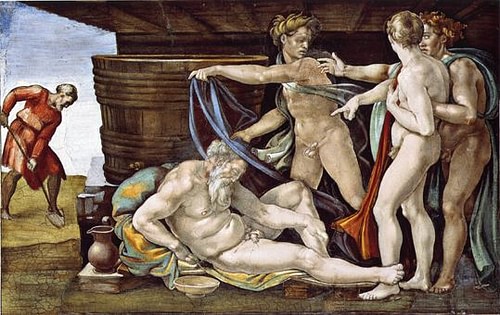
Canaan was the son of Ham. After the story of the flood, Genesis 10 has a list of nations, where the descendants of Noah’s sons are coordinated with geographical regions. "Later the Canaanite clans scattered, and the borders of Canaan reached from Sidon toward Gerar as far as Gaza, and then toward Sodom, Gomorrah, Admah, and Zeboyim, as far as Lasha" (Genesis 10:18-19). This story reflects events in the later history of Israel. The book of Joshua related the conquest of Canaan. Many of the tribal names made up the area from Lebanon (Phoenicia) down to Gaza. There is a consensus that the story of cursing Canaan was added later to justify the oppression and conquest of the Canaanites, where God orders their slaughter.
In the dispersion of the sons of Noah, the descendants of Ham were assigned to "Cush, Egypt, Put, and Canaan" (Genesis 10:6) Cush and Put may refer to Ethiopia and perhaps Somalia or the trading centers bordering the Red Sea. The descendants of Ham became associated with dark-skinned people in these regions. Noah’s second son, Japhet, and his descendants were assigned to the Mediterranean regions and later credited with the arts of civilization and intellectual ability. By the Middle Ages, Japhet was claimed as the ancestor of Europeans.
When later European colonists encountered African people, the story of Ham’s curse was applied for the justification of the slave trade. Anti-abolitionists in the Southern United States claimed that Ham’s curse resulted in black people being racially, intellectually, and behaviorally inferior to white people. Most modern Christian denominations no longer teach this concept.
The Righteousness of Noah
Over the centuries, writers filled in more details about Noah. In the Book of Jubilees and the Book of Enoch, we find claims that Noah was taught the arts of healing by angels so that his sons would overcome the evil of the Watchers. By the Middle Ages, the claim was made that Noah deliberately took 120 years to build the Ark, so that there would be more time for humans to repent. In addition, Noah’s creation of vineyards undid the result of Adam’s sin, when the earth only produced thorns. In this newer version, Noah invented the plow.
In both the gospels of Matthew and Luke, Jesus Christ compared Noah’s flood with the coming day of Judgement: "As it was in the days of Noah, so it will be at the coming of the Son of Man" (Matthew 24:37; Luke 17:28). The "Son of Man" was a pre-existent angelical being who would judge all humans when God’s kingdom was instituted on earth. Christianity claimed this "Son of Man" as the pre-existent Jesus. The letter of 1 Peter described the ritual of baptism as the same salvation for humans found in Noah’s Ark. In other words, the church functioned as the new ark; outside of the church, everyone would be condemned. The importance of Noah in early Christianity is demonstrated in the art of the Roman catacombs. On one of the tombs, Noah is portrayed with arms lifted in prayer, upon the dove’s return.
The sacred text of Islam, the Quran, mentions Noah 43 times. With the major theme of prophethood in the Quran, Noah became the model as one of the first "messengers of God" (26:107). At the same time, the narratives provided the template of the "rejected prophet". There are stories of how the people mocked Noah and would not believe him, as he was merely human. With their disbelief, Noah decided to build the Ark to save enough people to repopulate the earth.
The Search for Noah’s Ark
Like the Ark of the Covenant, people have been searching for Noah’s Ark from antiquity until now. Over the centuries, many individuals claimed to have found remnants of the Ark, particularly pieces of wood which became relics in some communities. The modern search began in earnest at the end of the 19th century in the new discipline of archaeology. Many of these excavations were begun in attempts to prove the historicity of the Bible. This is the period that also saw a detailed analysis of the story. How could four men (Noah and his sons) build such a large boat? The traditional dating of the story places it c. 4000 BCE. Did they have the tools and technology required for such an undertaking?
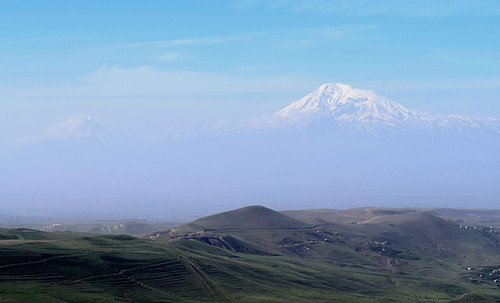
Genesis 8:4 says that it landed on the "mountains of Ararat", but even in antiquity, there was no agreement on which one. The modern search focuses on Mt. Ararat, located on the border of Turkey and Armenia. Various stories of exploration claim that local guides are the ones who know the location of the Ark, but all of this has been hearsay testimony. Many expeditions claimed to have found rock masses that appeared large enough for the Ark, now as petrified wood. Carbon-dating test results remain contradictory, and the Turkish government refuses permission to explore the mountain.
The story of Noah and his Ark remains popular in modern culture. There are hundreds of children’s books and toys (the boat and the animals). There is a replica of the Ark in a theme park in northern Kentucky. The latest Hollywood version Noah (2014) starred Russell Crowe, with some added Hollywood details. In this version, the Watchers are rock people (resembling science fiction Transformers), who help Noah build the Ark as an atonement for their sins.
